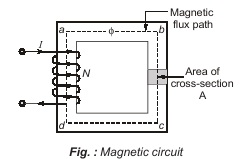Magnetic Circuits
MAGNETIC CIRCUITS
The complete closed path followed by the lines of flux is called a magnetic circuit. In low power electrical machines, magnetic field is produced by permanent magnets. But in high-power electrical machinery and transformers, coupling magnetic field is produced by electric current.

- In a magnetic circuit, the magnetic flux is due to the presence of a magnetomotive force same as in an electric circuit, the current is due to the presence of a electromotive force.
- The mmf is created by a current flowing through one or more turns.
MMF=Current × Number of turns in the coil
f=MMF = NI (ampere-turns) or (ATs) - The magnetic flux φ may be defined as the magnetomotive force per unit reluctance.
φ= MMF/Reluctance
where reluctance in magnetic circuit is similar as resistance in electric circuit. - The opposition offered to the magnetic flux is called reluctance,
Rl= l/μA (AT/wb)
where,
l=length of the magnetic path
A=area of cross-section normal to flux path, m2.
μ=μ0⋅μr = permeability of the magnetic material
μr =relative permeability of the magnetic material
μ0=permeability of free space = 4π × 10–7 H/m.
The permeance of a magnetic circuit is the reciprocal of its reluctance.
P= 1/Rl
Reluctances in a magnetic circuit obey the same rules as resistances in an electric circuit. The equivalent reluctance of a number of reluctances in series is the sum of the individual reluctances :
Rleq =Rl1+ Rl2+ Rl3+ …..
Permeances in series and parallel obey the same rules as electrical conductances.

